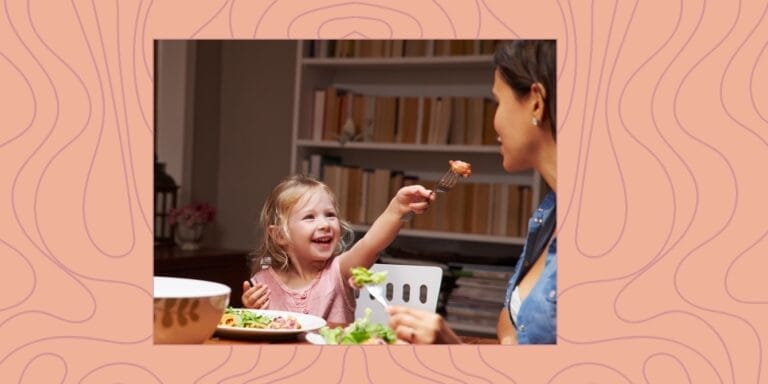The key to a good night’s rest for your children might be surprising, mama

Let the giggles flow freely.
Have you ever noticed how giggly and playful your children get in the evening? That at the moment you want to get them to wind down they start winding up?
Sleep advice often centers on getting children to calm down and relax at the end of the day. Sleep experts recommend everything from bedtime yoga, lavender candles or soothing meditation music. While relaxation is definitely key, most sleep advice is missing a key element: Laughter!
As parents, we’ve probably all battled with sleep problems at some point, and as a Hand in Hand Parenting instructor I’ve come to realize that a lot of our problems are due to a misunderstanding about how children’s emotions work, and how they affect sleep.
There are two main ways that children naturally process and release their emotions. One is crying. Tears contain cortisol, the stress hormone, so when children cry they are literally releasing stress from their body. As Dr. Deborah Macnamara says, “Crying is not the hurt, but the process of becoming unhurt.” Children often cry when they feel safe and connected to us, and want to let go of emotions from the times they weren’t feeling so great.
The other way children release emotions is through play and laughter! When children get to cry, laugh and play freely, with lots of warmth and attention from the adults around them, they tend to sleep very well.
However, sometimes children’s emotions get stuck. Difficult or traumatic experiences can be hard to process. A busy day at daycare or preschool means your child may need extra time to wind down. When children take a long time to fall asleep at night, wake regularly in the night, or too early in the morning, it’s often a sign that they have emotions to process. When they get giggly in the evening, they are naturally doing what they need to do in order to sleep well.
Studies have shown that laughter lowers blood pressure, triggers the release of endorphins, and contributes to lowering stress hormones. Just like adults, children’s sleep problems can be related to stress. So having a giggle-filled bedtime helps them de-stress and sleep well.
Laughter also builds connection. As comedian Victor Borges says, “Laughter is the shortest distance between two people.” When we laugh and play with our children before sleep they feel closer to us. Children experience sleep as a separation from us, even if they co-sleep, so laughter helps them to internalize a sense of us close to them, so they can let go and sleep.
Laughter even helps with the release of the hormone responsible for inducing sleep, melatonin. In one study breastfeeding mothers were divided into two groups. One group watched a Charlie Chaplin movie, while the others watched a non-humorous film. More melatonin was found in the breastmilk of the mothers who watched the Chaplin movie. Laughter is nature’s sleeping pill!
If you want your children to sleep well, then let the giggles flow freely at bedtime. Here are a few tips to optimize the sleepy power of laughter:
1. Let children be in the more powerful role
When children are in situations that are overwhelming or make them feel powerless, it can cause stress and upset. Laughter heals when the tables are turned and our child gets to have the power. So play pillow fights and let your child win and knock you over. Or play a game of ‘pajama chase’ where you try to put their pajamas on and they run away from you, and always manage to escape. Or read a bedtime story and add in the wrong words as if by accident.
Any situation where you are a bumbling adult making mistakes, and your child has the upper hand is bound to get them giggling.
2. Incorporate giggles throughout the bedtime routine
When children feel more connected to you they are more likely to cooperate, so laughter is a great way to get through bedtime tasks. With teeth cleaning you could try brushing their nose or ears instead of their teeth, or putting their pajamas on the wrong body parts, then you can act all confused and clueless at your ‘mistake.’
Games to get the giggles started
Children will often naturally start their own giggly bedtime, running away when you mention it’s time to clean teeth, or jumping on the bed. But just in case here are a few ways to get the giggle started:
1. Bedtime mix-up
Call a doll by your child’s name, and make a big deal out of getting them all into bed, then act suddenly surprised when you realize it’s not your child. Or take your child’s hand, and tell them it’s time for bed, and then lead them into the bathroom or kitchen instead of the bedtime. Act totally clueless and confused as you try to ‘look’ for the correct room.
2. I hope you don’t…
In a playfully-serious tone, you can invite your child to do something that you pretend you don’t want them to do. For example, jumping on the bed, or throwing their plush toys out of the bedroom. Then you can act all playfully ‘annoyed’ and frustrated, as you try to catch them, or put the toys back. Obviously, it should be something you don’t really mind them doing so that you can turn it into a fun game.
Pro tip: If you are introducing play at bedtime for the first time, you may find that it seems like your child wants to play all night long! Children lap up this kind of laughter-filled attention because they instinctively know it’s good for their bodies, minds and souls. As a giggly bedtime becomes part of their regular routine this will reduce with time, so bear with it. At first you might want to start the bedtime routine 10-15 minutes earlier so you can factor in extra giggle time and save the weekends for extra-long playtime.
When you’ve had some time to get all the giggles out, signal to your child that now it’s time to calm down by taking a few deep breaths, reading a story and singing a song. Embrace the fun of bedtime, and the magic of childhood with your little one—and hopefully get some better sleep too.
You might also like:
- I sacrifice sleep for ‘me time’ and it’s hard to stop
- The 4-month sleep regression struggle is real
- The science of sleep: 10 ways to build a better bedtime


































